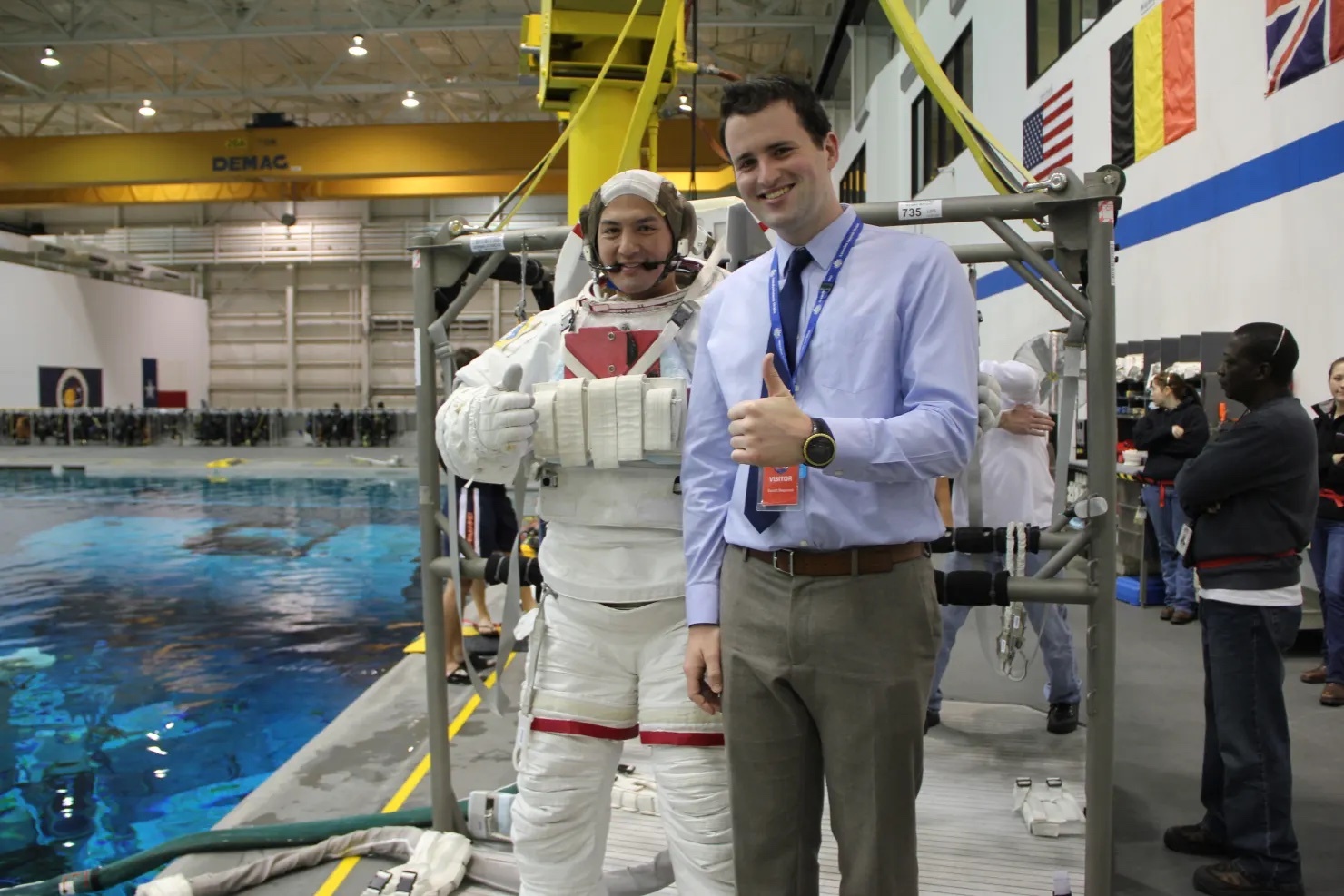3.07.2023
Australian doctors caring for patients from the outback to the Antarctic are gearing up to help NASA’s next generation of astronauts adjust to life in space and, eventually, Mars.
Experts from across the space and medical communities gathered in Sydney on Friday and Saturday as NASA’s Artemis program prepares to return humans to the moon for the first time since the Apollo missions.

Dr John Cherry with astronaut Kjell Lindgren at NASA’s neutral buoyancy facility in Houston, Texas.
Dr John Cherry, a rural medicine specialist and director of the Australasian Society of Aerospace Medicine at Sydney’s Kolling Institute, said Australia’s track record providing healthcare in extreme and remote environments would help the agency’s ambitions to ultimately reach Mars.
“No one in the world does rural healthcare as well as we do, and no one in the world does Antarctic healthcare as well as we do,” he said. “Utilising that experience and that knowledge is going to be key to keeping astronauts safe, from a medical point of view, as they venture deeper into space.”
From selecting suitable candidates to helping astronauts transition back to gravity on Earth, Australian researchers and doctors are already paving the way for humankind’s next foray into space.
Pre-launch
Just as Australia’s Antarctic program assesses the physical and psychological fitness of potential candidates, prospective astronauts are screened for any chronic or underlying conditions that could become a problem once they’re launched beyond the stratosphere.
Next, the selected candidates will be given medical and technical training to help them deal with everything from medical emergencies to the daily rigours of space on the body.
“Not every astronaut who goes into space is going to be a medical doctor – far from it,” said Cherry, who helped the European Space Agency redesign the medical training given to their astronauts.
“If you have a crew where there is no medical doctor, the teams need to be able to still provide medical care to themselves and their fellow astronauts if something were to go wrong.”
In space
Once the astronauts are launched outside the Earth’s atmosphere, a dedicated flight surgeon or doctor will check in on their health with weekly or fortnightly telehealth appointments.
What happens to your body in space?
Muscles and bones: Weight-bearing bones lose over 1 per cent of their mineral density per month during spaceflight, and muscle mass also declines faster in microgravity without exercise.
Balance: Motion sickness can arise when the sensors in our inner ear responsible for balance can’t feel the familiar pull of gravity. The vestibular system gets used to this, but becomes deconditioned over time, which can cause further problems with motion sickness upon returning to gravity.
Blood pressure: The body’s ability to regulate blood pressure deteriorates the longer a person spends in space, which can result in lightheadedness and fainting once they return to gravity.
Vision: The fluids in the body shift upwards into the head in microgravity, which can put pressure on the eyes and cause problems with eyesight. These issues usually correct themselves on returning to Earth, but can take longer for some people.
Radiation: Outside the Earth’s magnetic field, astronauts are exposed to varied and increased levels of radiation. As we aim towards long-duration spaceflight to Mars and beyond, scientists will need to come up with ways to shield astronauts from long-term exposure to harmful rays.
To counter the effects of microgravity on the body, astronauts do a range of exercises to keep their muscles and motor skills finely tuned. However, a six-month trek to Mars would be a different ball game.
“We’re really not sure yet how that’s going to impact their bodies, so having technology to monitor it is really useful,” said Professor Carolyn McGregor, an Australian space health expert helping the Canadian Space Agency monitor astronaut health in space.
The program collects data on an astronaut’s heart rate, breathing, and blood oxygen levels through a tight-fitting “bio-monitor” shirt. The data is then fed into an artificial intelligence computing program and analysed for insights into how the astronaut’s cardiovascular system is tracking.
McGregor said the findings of her study could help doctors back on Earth treat people who have gone through similar periods of deconditioning, such as those who have had extended stays in hospital beds.
Returning to gravity
Landing back on Earth – or Mars – will be just as great a challenge for the NASA medical teams.
The body’s ability to regulate blood pressure deteriorates the longer a person spends in space, which can cause a drop in blood pressure on the return to gravity. That poses a problem for astronauts landing on Mars, a long way away from medical support.
“On Mars, there isn’t a welcoming committee, there are no doctors and physios to help you transition. You’ve got to do it all yourself,” said Dr Gordon Cable, a specialist in aerospace medicine whose Adelaide-based startup is developing a post-flight “G-suit” to help astronauts transition back to gravity.
Cable said Australia was globally recognised for its research and innovation in the field of space medicine.
“The US and NASA are keen to collaborate with us … Australia has got a lot of horsepower when it comes to medical research,” he said. “Space medicine will only become increasingly important as more humans go to space.”
Quelle: THE SYDNEY MORNING HERALD

